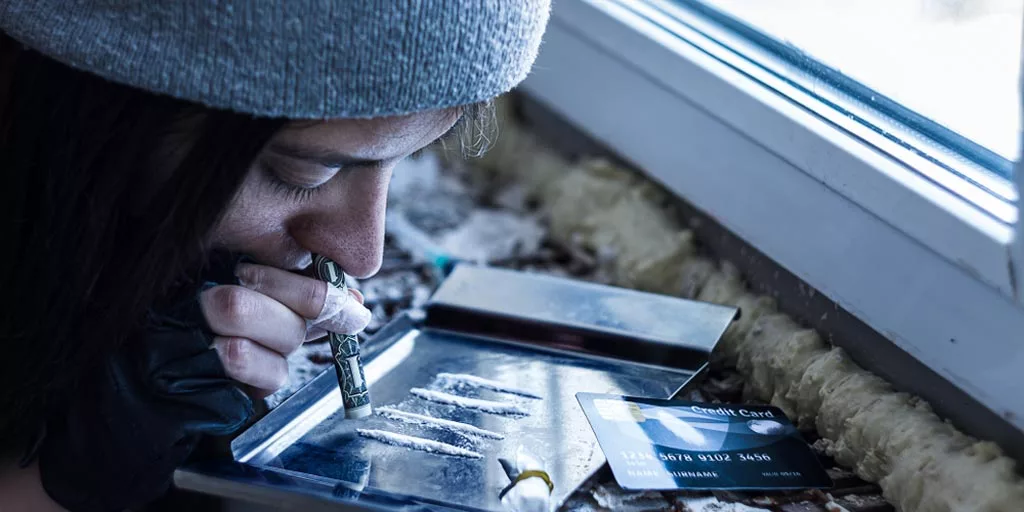Getting Effective Programs to Treat Cocaine Abuse
If you or a loved one have been struggling with ‘nose candy’ for some time, you may already know that cocaine addiction treatment is the best way to recover from cocaine dependence and get a leg up on your recovery. This happens through education and the right forms of therapy, all offered in safe setting. However, this is difficult to accomplish without the right strategy and ample knowledge regarding your fight against this terrible disorder.
At South Shores, our drug abuse treatment programs provide the tools you need to gain a deeper understanding of addiction, including the mental health disorders often at the center of a drug abuse problems. Without the right plan of attack, you run the risk of staying in the same tragic cycle of recovery and relapse for the rest of your life.
Because of the fentanyl and methamphetamine epidemics, cocaine has almost taken a back seat as the public has become enamored with the constant damage control due to fentanyl and the lives it’s taking. However, cocaine addiction is alive and well, and still as dangerous as it ever was.
If you’re looking for help with coke, South Shores Recovery offers a robust program that incorporates every level of care with dozens of options for the successful treatment of cocaine use disorders.
Keep reading to find out more regarding the dangers of cocaine addiction and how you can get help at South Shores to reclaim your life!
How Does Cocaine Make Its Way to Our Streets?
Although healthcare professionals can sometimes use cocaine for certain medical procedures, such as local anesthesia, the drug is still illegal at the state and federal levels.
Colombia is the main supplier of cocaine in the US, and the drug is mainly trafficked through Mexico by powerful cartels. Its powder form is usually white and comes in various shades. When wrapped in kilos, the drug takes on a solid appearance and is compressed into tightly packed bricks to be transported into the United States and elsewhere.
To maximize their profits, drug dealers usually buy large quantities of cocaine at wholesale prices and then mix it with various other substances, such as laxative powders and other crude substances.
The National Institute on Drug Abuse (NIDA) also indicates that fentanyl is increasingly found in cocaine, meaning the necessity of cocaine treatment is even more urgent. The presence of this deadly opioid has meant higher numbers of cocaine overdoses nationally.
How Addictive Is Cocaine?
Cocaine is one of the most addictive substances on the market. During cocaine addiction, things happen in the body and brain that don’t happen with other forms of drug abuse.
Regardless of how one chooses to abuse cocaine, the subsequent feeling in the minutes after use is known as “the jones.” This is the almost instant craving to continue taking the drug and can be one of the hallmark signs of cocaine use.
This unique characteristic of cocaine doesn’t seem to happen with other types of substance abuse. That said, every drug has an affinity for causing addiction and dependence. However, in cases of other drugs, the yearning for more takes place over the course of hours and even days.
This is because of the chemical makeup of cocaine and the way it acts in the brain. Immediately after someone engages in cocaine use, a burst of euphoria overtakes them – it’s this burst, that keeps people coming back for hit after hit.
The Action of Cocaine Addiction In the Brain
In order to treat cocaine addiction, you have to know exactly how cocaine use impacts the brain. When it comes to substance abuse, different drugs affect the brain in different ways. Cocaine, acting on the central nervous system and receptors, causes a significant release of dopamine and intense firing of neurons.
The reward pathway in the brain is activated by various types of stimuli, such as sex, chemical substances, and food. It can be traced back to the midbrain’s dorsal tegmental area. This region is also one of the main areas of the brain that is responsible for controlling the reward system.
Besides controlling the actions of the brain’s reward system, this circuit also monitors the emotions and motivation of individuals. In the normal communication between the two neurons, the chemical dopamine is released by one neuron into the synapse.
The Hijacking of Your Pleasure Centers
The chemical dopamine is transported by a protein known as a transporter, and this process is carried out to recycle the chemical from one neuron to another. However, when drugs such as cocaine are used, the removal of this chemical from the synapse is blocked.
When drugs are used, the chemical dopamine can accumulate in the synapse, which then produces an amplified signal for the receiving neuron. This causes the user to feel high.
Essentially, it’s the elimination of the dopamine cycle that causes the constant urge to continuously snort a line or take a hit of crack cocaine. These dopamine bursts and the constant influx of dopamine keep the user on a chase for a high that they’ll likely never feel the same way they did their first time.
After the drugs are gone and the user is no longer able to get high, this is why there’s a sinking, depressed feeling. You go from insane amounts of dopamine to no release at all.
Does Cocaine Use Cause Withdrawal After Quitting?
It could be said that nearly every drug has some type of withdrawal associated – some are just more severe than others. When someone engages in cocaine abuse, the more intense their method of ingestion is, the more severe the withdrawal is likely to be.
For example, someone who snorts during cocaine use probably won’t experience withdrawals like those who smoke crack cocaine. Regardless of the severity of the withdrawals of any substance abuse, a detox period always takes place.
Detox simply means the process of elimination from the body. Even in the least severe cases, there is at least some form of mental withdrawal. However, even when snorted, cocaine does produce physical effects during detox. So what happens during cocaine detox? It’s important to be aware of this stage of the cocaine addiction treatment process.
Can Cocaine Detox Help With Withdrawal Symptoms from Coke?
Although many of the cocaine withdrawal symptoms are mental, these can correlate directly to the condition of the body and lead to physical symptoms. The following are the most common symptoms of cocaine withdrawal:
- A lack of concentration
- Cocaine jaw issues (although more common during active use)
- Paranoia
- Stomach cramps
- Nightmares
- Lack of sleep
- Depression
- Anxiety
- Increased heart rate
By this measure, the highest chances for physical withdrawal symptoms include stomach issues, and the side effects from anxiety, depression, and lack of sleep. For those with long-term cocaine abuse histories, damage to the nose from coke, and even changes to facial structure, can be addressed following successful detox.
These are dangerous enough to warrant the possibility of needing a medically-assisted detox during this period – if for nothing more than to monitor vitals and prescribe some type of sleep aid. The next logical step is the transition into our inpatient programs for cocaine addiction treatment.
Levels of Care Available for Substance Use Disorders Involving Cocaine
Cocaine users have many options when it comes to levels of care, with both residential and outpatient settings available at South Shores. The following seem to be the most effective:
Outpatient Cocaine Addiction Treatment Centers
One of the most common treatment methods is outpatient therapy, which involves seeking professional help at a time when the client is still living in their normal home. These usually include two sessions per week for 2-3 hours each session.
This type of treatment allows the user to continue with their daily activities, such as working and maintaining their hobbies and social life. However, some people find it more effective in an inpatient facility. This level of care would likely be recommended to someone who had a moderate cocaine addiction via snorting.
Residential Treatment Programs for Cocaine
Inpatient drug rehab or rehabilitation is a type of treatment that involves staying in a residential facility, which may or may not include a medically-assisted detox. This type of facility allows clients to meet with a counselor and gain access to peer groups. It also helps them identify their triggers and develop a plan to stop using.
Most likely, those who inject or smoke cocaine would benefit more from a residential treatment facility. This doesn’t rule out those who snort cocaine attending an inpatient treatment facility – there are plenty of cases severe enough to warrant an inpatient program for those who insufflate the drug.
Off-Site or On-Site Support Groups
Support groups are also a type of cocaine addiction treatment that can be used by individuals struggling with addiction. These groups can help them beat their habit by providing them with a strong support system. Some people choose to use a support group as a part of their recovery program, while others prefer to combine outpatient therapy with regular sessions.
These groups can be added to an individual’s recovery program following the completion of inpatient therapy. It’s important for patients to be serious about their recovery, regardless of the treatment method. It’s possible for someone to participate only in support groups to combat their cocaine addictions. This would be similar to a light-to-moderate alcoholic solely attending AA meetings without rehab.
For those who do participate in a treatment program at an actual rehab facility, what do the specific options for therapy include? What’s been the most effective approach historically?
What Does it Mean to Treat Cocaine Addiction?
Receiving mental health services for substance abuse involving cocaine includes the possibility of detox with a recommendation of inpatient treatment depending on the severity of individual cocaine use disorders. Multiple types of behavioral therapies are the most effective, according to the Mental Health Services Administration. Let’s look at the most common modes of therapy during rehab for substance use disorder:
Various Behavioral Therapies
Individuals suffering from substance abuse disorders can undergo treatment programs that focus on changing their behaviors. These programs can be carried out in either inpatient or outpatient settings. One particular type of treatment is cognitive-behavioral therapy, which has shown promising results in treating cocaine addiction.
Rewards-Based Cocaine Addiction Treatment
One of the most effective ways to treat cocaine addiction is through reward-based therapy. This type of therapy involves rewarding individuals for abstaining from using drugs. This method can help individuals understand the triggers that cause relapse.
Combining Traditional Psychotherapy with Holistic Options
Individuals who use stimulants often experience various mental health issues due to how these drugs affect their nervous systems and brain. Some effective treatment techniques include behavioral therapy and healthy eating habits through a clean or green diet regimen rich in superfoods.
Exercise and Yoga
Besides improving one’s physical health, regular exercise can also help individuals with mental health issues. Holistic options involving yoga and even spa therapy are powerful ways to cope with cocaine addiction through treatment.
Medication-Assisted Cocaine Addiction Treatment
Cocaine abuse treatment involves the use of pharmacotherapies, which include prescription drugs. There are various types of medications that can be used for this disorder, such as antidepressants and other psychological drugs. Some of the behavioral therapies that are commonly used for cocaine addiction include cognitive-behavioral therapy, 12-step therapy, surf therapy (a specialty of South Shores), and contingency management.
Evidence-Based Options for Cocaine Addiction Treatment
The two most popular treatment methods for cocaine addiction are the Matrix Method and contingency management. The matrix model helps individuals maintain their abstinence from illicit drugs by providing a framework that encourages positive changes in behavior. Therapists use various methods to reinforce positive changes.
In contingency management, rewards are used as a way to promote abstinence. Clients are given vouchers for clean urine samples and hitting milestones with their counselors. These vouchers are used to redeem certain privileges and other prizes during the treatment program.
It’s possible to stack the levels of care mentioned previously to slowly make your way through the entire rehab system, using all of the therapies mentioned as well. When it comes to recovery, there’s no such thing as too much treatment.
The longer you reinforce the ideals and principles taught in treatment centers and maintain clean time, the higher your chances are of making a successful recovery.
Get Effective Treatment for Cocaine Today
If you or someone you love needs substance abuse treatment for cocaine, South Shores Recovery in Orange County has all the tools and support that you need to experience long-term recovery.
For more information on how we can help you, contact a member of our admissions team today for a confidential consultation. Get options for your recovery now!





